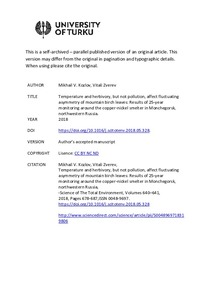Temperature and herbivory, but not pollution, affect fluctuating asymmetry of mountain birch leaves: Results of 25-year monitoring around the copper nickel smelter in Monchegorsk, northwestern Russia
Vitali Zverev; Mikhail V. Kozlov
Temperature and herbivory, but not pollution, affect fluctuating asymmetry of mountain birch leaves: Results of 25-year monitoring around the copper nickel smelter in Monchegorsk, northwestern Russia
Vitali Zverev
Mikhail V. Kozlov
ELSEVIER SCIENCE BV
Julkaisun pysyvä osoite on:
https://urn.fi/URN:NBN:fi-fe2021042719368
https://urn.fi/URN:NBN:fi-fe2021042719368
Tiivistelmä
Fluctuating asymmetry ( FA), which is defined as the magnitude of the random deviations from a symmetrical shape, reflects developmental instability and is commonly assumed to increase under environmental and genetic stress. We monitored the leaf FA of mountain birch, Betula pubescens subsp. czerepanovii, from 1993 to 2017 in individually marked trees at 21 sites around the copper nickel smelter at Monchegorsk, and we then analysed the results with respect to spatial and temporal variation in pollution, climate and background insect herbivory. Responses of leaf FA to different stressors were stressor specific: FA did not correlate with pollution load, it decreased significantly with an increase in June air temperature and it increased slightly but significantly with an increase in the previous-year leaf damage due to defoliating and leafmining insects. Our findings suggest that climate warming is unlikely to impose stress on the explored mountain birch populations, but even small increases in insect herbivory may adversely affect birch trees. However, these conclusions, since they are based on an observational study, should be viewed as tentative until confirmed by controlled experiments. We also demonstrated that the use of non-blinded measurements, which are prone to confirmation bias, was the primary reason for the earlier report of an increase in birch leaf FA near the Monchegorsk smelter. We hope that our findings will promote a wide use of blinded methods in ecological research and that they will contribute to debunking the myth that plant leaf FA consistently increases with increases in environmental pollution. (C) 2018 Elsevier B.V. All rights reserved.
Kokoelmat
- Rinnakkaistallenteet [19207]
